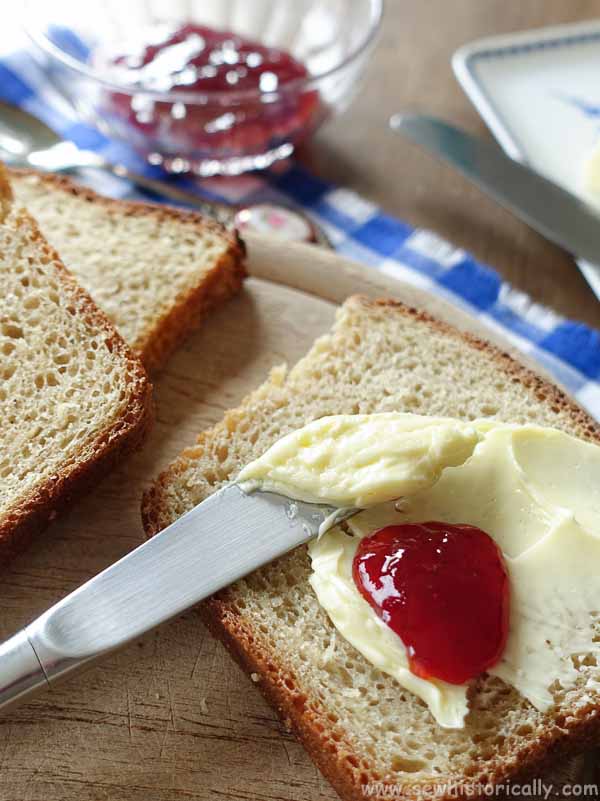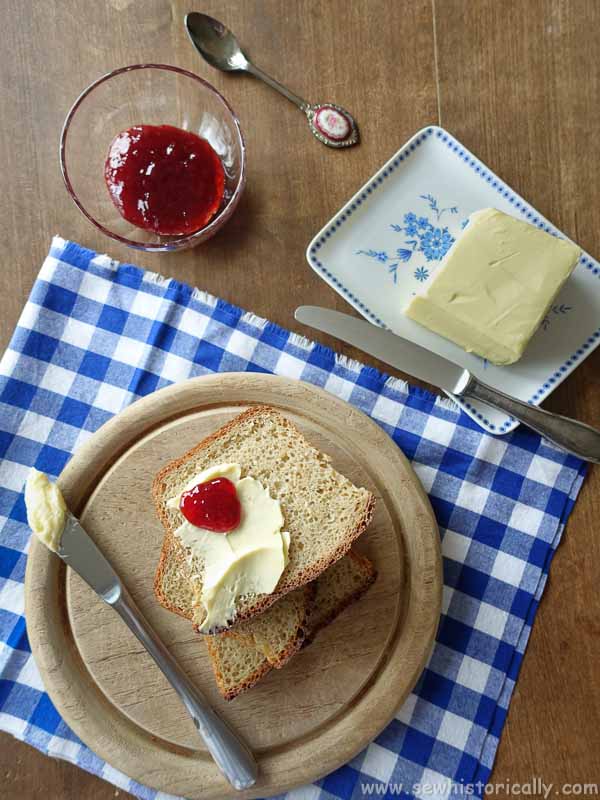This old-fashioned salt rising bread has a mild taste. Unlike other salt rising bread recipes it has absolutely no cheese taste! And although it’s made from scratch, it’s quick to make: the bread is ready in just 7 hours! The Victorian salt rising bread is even allergy-friendly because it’s dairy-free, yeast-free, nut-free and vegan!
‘Salt-rising, or rather milk-rising bread[…] looks finer, tastes better, and is more healthy, beside being less work about making it than the common yeast bread. […] This bread if made aright, is white, moist, tender, [and] sweet’ (The Ohio Cultivator, 1859, p. 223).
The recipe for this salt rising bread is actually from the Victorian era, from 1859 to be precise! If you follow my blog, you know that I’m trying out old recipes from time to time: Victorian recipes, Edwardian recipes, Depression era recipes and sometimes even medieval recipes! And making this Victorian salt rising bread was on my list for a long time and now I finally made it!
The Victorian salt rising bread is the sixth recipe in my series about historical bread recipes without commercial yeast. So after baking fruit yeast bread, sprouted sourdough bread from scratch, Turkish chickpea yeast bread, hops potato yeast bread and bread with homemade brewer’s yeast substitute, I’m now trying out this Victorian salt rising bread recipe.
Related: 10 Victorian Bread Recipes Without Commercial Yeast
There are many different recipes for old-fashioned salt rising bread: Some are made with milk, while others are made with water instead. And most salt rising bread recipes contain cornflour and potatoes. This recipe, however, is made without cornflour and potatoes.
Salt Rising Bread Ingredients
The Victorian salt rising bread is made with flour, water, salt, (vegan) milk and sugar or molasses.
Salt
Despite the name, salt rising bread doesn’t contain a lot of salt. The salt, however, is necessary because it suppresses the yeast growth. Salt rising bread is a no-yeast bread. The bread rises because of a bacteria – more about it below.
Milk
I used soy milk but you can substitute it with any other vegan milk. And if you eat dairy you can even use regular milk because the Victorian recipe actually called for milk.
Water
I used tap water because it doesn’t have chlorine in it where I live. But you can also use spring water or bottled water.
Flour
I used first clear flour for the starter and all-purpose flour for the bread dough. But if you don’t have first clear flour, just use all-purpose flour or bread flour for both, the starter and the dough.
Molasses (Sugar)
The Victorian recipe says to either add molasses or sugar. I used molasses here.
What Causes Salt Rising Bread To Rise?
As I’ve mentioned before, salt rising bread rises because of bacteria: Clostridium perfringens. This is the bacteria that gives you food poisoning so you should NEVER taste the bread dough before it is baked! However, salt rising bread is perfectly safe to eat after baking because heat destroys the bacteria. Victorian chickpea bread also uses clostridium perfringens as rising agent.
How Does Victorian Salt Rising Bread Taste?
Some people describe the taste of salt rising bread as cheesy. This Victorian salt rising bread, however, doesn’t taste like cheese at all! It has a very mild, sweet and rich taste. It tastes almost like egg-and-butter-enriched quick bread or German sweet bread but without the yeast taste.
So if you’re looking for a bread that doesn’t taste sour like sourdough bread, or yeasty like yeast bread, or savory and cheesy like other salt rising bread, this it it! Because this Victorian salt rising bread tastes so mild, sweet and unobtrusive, you can simply eat the bread straight as it is. But it also tastes good with butter and jam, or with savory toppings like cheese or ham.
Victorian Salt Rising Bread Recipe
Starter
- 1/4 pint (115ml) soy milk
- 1/4 pint (115ml) boiling water
- 1 cup (120g) flour
- 1/4 tsp salt
Combine The Ingredients
‘Take a perfectly clean bowl, and one that has not had any acid substance like cooked fruit in it.’ (Guide For Nut Cookery, 1898) Combine soy milk, boiling water and salt in the bowl. Add about 1 cup ‘flour very fast, until as thick as can well be stirred smoothly’ (The Ohio Cultivator, 1859, p. 223). Stir until all lumps are gone and the starter is completely smooth. It should look like pancake batter.
Water Bath
Now pour hot water into a larger bowl and put the bowl with the starter in. The Victorian recipe says the water should be as hot ‘as the hand can be held in’ (The Ohio Cultivator, 1859, p. 223). But you can also check with a thermometer: it should be between 104 and 113°F (40 – 45°C).
Cover the water bowl with a kitchen towel and wrap more kitchen towels or a blanket around so that the bacteria have it nice and warm! 😉 Check from time to time that the water is still warm enough. Add more warm water if necessary.
Stir The Starter
‘Give it a slight stirring, and that but once, which should be done upon seeing signs of its rising, which will be after it has stood between three and four hours. Will be up in about five hours. Should not present a surface of fine bubbles, but look much as yeast.’ (The Ohio Cultivator, 1859, p. 223) The starter should smell like stinky cheese now, have risen very much and look bubbly when you stir it.

Bread Dough
- 6 cups (720g) flour
- 1/2 quart (475ml) warm soy milk
- pinch of salt
- 1 tbsp molasses or sugar
Combine The Ingredients, Stir & Let It Rise
Salt rising bread ‘requires much less kneading than yeast bread.’ (Guide For Nut Cookery, 1898) ‘Mix moderately stiff, and mould out into pans, set by the stove to rise.’ (The Ohio Cultivator, 1859, p. 223) You don’t have to knead the bread dough, just stir all ingredients together with a spoon. Then put the dough into a greased pan and let it rise in a warm place for another hour. When the dough is at least doubled in size, it’s ready to bake. My bread has risen so much that the pan overflowed! 😀
Bake
Preheat the oven to 400°F (200°C). And bake the Victorian salt rising for 1 hour. ‘Will bake a little quicker than yeast. […] If the rising be set at six in the morning, the bread can be mixed at eleven, and all in the cooling room at two o’clock, so as not to interfere with the arrangements of the afternoon.’ (The Ohio Cultivator, 1859, p. 223)





for the salt rising bread, do I make the starter, then make the batter, and just stir them both together?
Yes, you just stir the starter and all other ingredients for the bread dough together. 🙂
This may be a wonderful bread, but it is NOT Salt risin’ bread as made in the south, starting with an old potato.
The recipe is adapted from two original bread recipes from the Victorian era (1859 & 1898): and both breads were made without a potato and were called “salt rising bread”. Breads made with a potato starter were called “potato yeast” bread in the Victorian era.